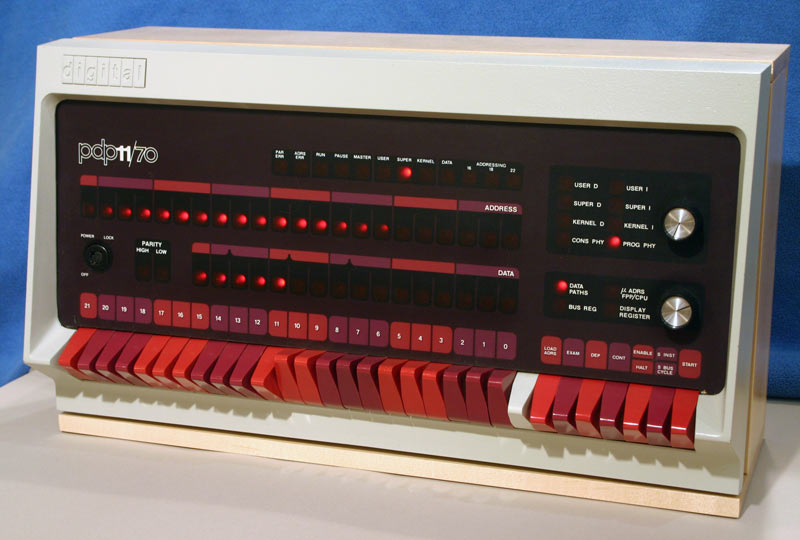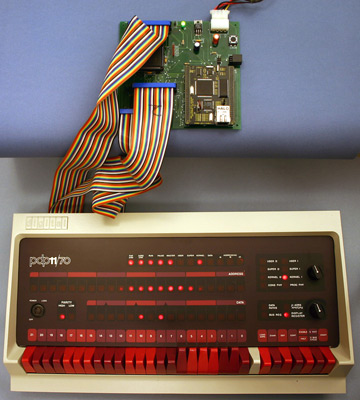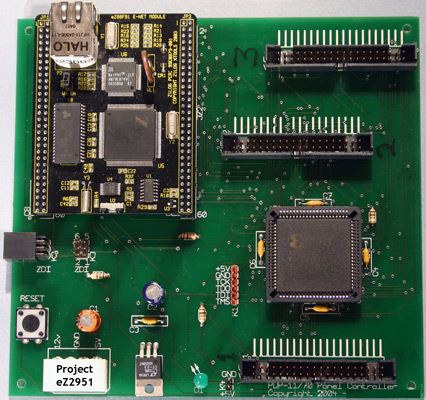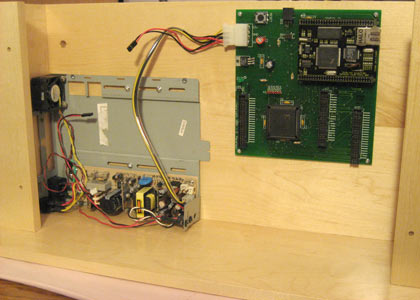



When computers first appeared, one of the most distinctive things about them was the complex array of blinking lights and switches. It was an exciting look, and for many years the rows of mysterious blinking lights became the very stereotype of what a computer was.
By the early 80's, microprocessor based front-end processors connected to terminals replaced the lights and toggles, and computers morphed into bland metal boxes with little more than a power switch and an "on" light. The visual excitement of large computers was lost. This point hit home when I was in college and the local TV news crew came to our school's computer center to cover the installation of an expensive new mainframe. When we watched the report on TV that evening we were chagrined to see it featured video of...the air conditioner. That was the only machine in the room with blinking lights.
Like many who became acquainted with computers in the mid-70s, one of the first machines I used was the DEC PDP-11. Of the PDP-11's built with blinking lights and switches, the largest was the 11/70. As a computer it's small by today's standards (your cell phone has more compute power), but physically it was non-trivial. A typical installation occupied at least two (usually three or four) full height equipment racks painted black with pink and purple trim. Each DEC operating system had a unique light show running on the control panel when the machine was idle. If the machine was busy the lights sparkled and dimmed as it crunched away
I've always missed that visual and tactile aspect of computers that's been lost since the advent of microprocessors. When a console for a PDP-11/70 came up for sale on Ebay, I couldn't resist the opportunity to bring it back to life.
I used a Zilog EZ80F91 based Ethernet controller along with a Xilinx XC95108 CPLD to hook up all the lights and switches and make them controllable over the net. A technical overview with schematics is available (PDF 1.9MB), along with a more detailed article (PDF 165K) describing the design. There's also plans for a mounting case (PDF, 1.3MB).
The project was cited for "Distinctive Excellence" in the Zilog 2004 Flash Nets Cash Design Contest.
Many thanks to Tom Uban for providing a set of schematics for the panel - this was a huge help in doing the design. (The schematics for the 11/70 panel are now up on BitSavers).
If you're interested in control panels, be sure to check out The Gallery of Old Iron, where Dan House has brought some great IBM panels from the 60's and 70's back to life. Henk Gooijen created a similar "PDP-11/70 in a box" driven by a single-board PC. He has nice page detailing the PDP-11/70 and explaining what all the switches and lights do. He's even built similar front panels from scratch. Also check out the adapter board Bob Armstrong of Spare Time Gizmos did to hook up a PDP-11/40 panel to the Ersatz-11 emulator running on a PC. Here's a video of a running PDP-11/70 (unfortuantely, it's running RT-11 which doesn't have a fun idle loop display in the lights).
Update Dec 2004
It's finally in the case I designed a year ago, beautifully
fabricated in wood by Calvin Davis of Forest Grove, Oregon (thanks
Mom!)

